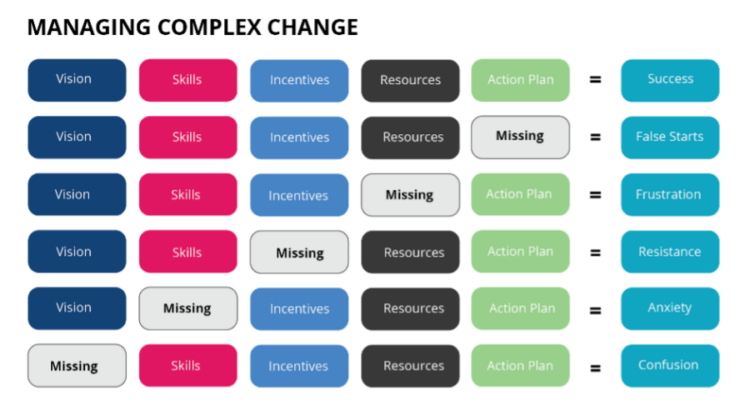Projects that don’t gain traction right out of the gate typically have a few warning signs. A false start can be a setback for a project, but it can also be an opportunity to re-evaluate and make necessary adjustments to get back on track .
There are many parallels between delivering successful projects and complex change. Both require vision, the right skill mix, appropriate incentives, adequate resources, and a clear action plan to succeed.
One of the more critical enablers for a successful project is stakeholder buy-in – and not just what’s in it for them. Stakeholders across the organisation who understand what is being delivered, why they should be excited about it, and how it will benefit the business are some of the best ambassadors a team can have to support its success.
However, it’s not uncommon for a project to start with great enthusiasm or effort and then lose momentum with little or no progress towards its goals and that rarely happens without some warning signs that don’t necessarily show up on a project dashboard.
If a project isn’t gaining traction right out of the gate, it’s often because one or more elements required for success are missing or ill-defined and, in this case, it’s useful to look at a model for change and how it applies in project delivery.
Managing Complex Change Model: 5 Elements for Success
The Lippitt-Knoster change model defined the five elements that are required for change to succeed:

Source: Lippit-Knoster
For complex change to be successful, it requires all five elements: vision, skills, incentives, resources, and action plan. If any of these elements are missing, the change effort may fail.
Similarly, in project delivery, even if the context may be different, missing elements that lead to frustration, resistance, anxiety, confusion, or the lack of an action plan are all likely to contribute to projects either not getting out of the gate or slowly ebbing enthusiasm for its success as progress isn’t made.
This model is a great reference point for many reasons. It illustrates clearly what elements are needed for projects to succeed and it can provide an aha moment for project leaders who are trying to understand what might be creating less obvious issues within their projects or why there may not be a broader buy-in.
Let’s look at each element in turn.
Missing: Vision
Vision is critical to providing your project team and stakeholders with a definition of success and a picture of what the future looks like.
Without a clear vision, the people who are involved in a project may experience a sense of confusion which can show up as teams and stakeholders pulling in different directions, relitigating decisions, or simply being at cross-purposes.
There are few warning signs of this when this issue starts to surface. It shows up as different interpretations of the vision or lack of buy-in from stakeholders and sponsors – all of which can stall or slow down the project.
As a leader within your organisation, if you are observing this sort of behaviour, it’s important to seek common ground among those involved in the project, including both the team delivering it and any stakeholders.
Working with those involved to provide a clarifying vision and direction to pursue, even if it’s an abstract, will ensure that a vision is shared and support the buy-in required to succeed.
Missing: Skills
We often talk about resources and skills in the same breath within project delivery but they’re actually different. Roles and expected skillsets are standard requirements in successful projects, but there are other requirements in the equation.
Creating the right mix of capability and capacity in a project is important. It’s one thing to have the right capability, but if the capacity isn’t there, it’s likely to induce some anxiety among your team. Equally, not having the right skills but having capacity may require that people ‘play out of the position’ and whilst they will do their best, a best-endeavour effort does not guarantee results.
Not having the right skills in a project is likely to create delays, rework, and impact the quality of what’s being delivered and that can create stress, anxiety, and often burnout when your people are trying to work harder or longer to make up for the missing capability.
Solving for skill gaps is challenging. This is where a priority call might be required to redeploy people from one project to another, but that’s robbing Peter to pay Paul.
Building skills takes time and investment. If your internal teams don’t possess the right skills for your project, having trusted partners to augment them and cover those gaps is one way to access skills on demand and avoid costly time delays.
Missing: Incentives
It’s a loaded word: Incentives. In most organisational contexts, it invokes remuneration and bonuses and whilst that can be part of success, on a deeper level, the incentive is often about a person’s best interest.
Project team members and stakeholders will be challenged if they work on a project that is not in their best interest and that can create an environment of resistance, disengagement and – at worst – revolt.
Unfortunately, there are times when an organisation’s decision will be in conflict with an individual’s needs and looking to avoid that situation will not always be a possible strategy.
There are alternative strategies: acknowledging conflicts of interest and taking action to resolve any imbalance or perceived unfairness can help improve engagement and reduce resistance.
These are complex stakeholder management situations and will be very dependent on context, relationships within the organisation, and collective experiences.
Missing: Resources
There are fewer more frustrating situations than having a great vision, the skills do it, strong benefits or incentives … and not having the resources to deliver.
Most people in the project world are action-takers: we love to get things done and make them happen and frustration is the most common and easily identifiable emotion that rises up when we can’t. As mentioned about skills above, resolving a lack of human resources has the same or similar problem-solving strategies or challenges: it’s rarely straightforward to resolve.
But there are many types of resources that can support a team: physical or non-physical assets, materials, tools, and much more. If the human resources are not easily solved, it’s worth investigating what can support the project.
Resolving the lack of resources can be challenging if not addressed in the planning stages as very often, it’s difficult to obtain or access once the project is up and running and the impacts have already occurred.
Missing: Action Plan
Don’t stop reading, please. We may be hearing murmurs or chuckles from the gallery and we all know the idiom of failing to plan is a plan to fail. But is it that simple? Will any plan do?
No, of course not. When starting a project, deciding the path to take isn’t always so easy as different routes to the outcome can present different risks, require different skills or resources, and those need to be balanced against constraints. There are often a lot of unknowns at the start of the project process and assumptions are often made.
Leaders should pay careful attention to what can be learned as the first project steps are taken. The lack of an action plan – or the wrong action plan – can lead directly to the need to stop, take stock, reset, and start again, which can be a costly exercise.
Are your projects missing one or more of these elements?
As the Lippitt-Knoster model indicates, missing any of these elements can lead to false starts. If left unaddressed, the consequences can be difficult to overcome: a missing vision that drives the project in so many directions that it loses purpose and focus; the lack of skills that erodes quality to the point of knock-down and rebuild; the lack of incentives that derails engagement and fosters resistance; the lack of adequate resources to deliver the vision; and of course, the lack of action planning that can force costly mistakes.
Getting all five elements right will de-risk a project early and ensure that the critical stages of a project establish the right foundations for successful outcomes.
Talk to us if you think your project is missing the key elements for success, as we can support your team with health checks and a set-up for success review. Contact us here to find out more about how we work or call 1300 841 048
We believe that quality thought leadership is worth sharing – click on any of the links below to share with your colleagues. If you’re interested in republishing our content, here’s what’s okay and not okay.

